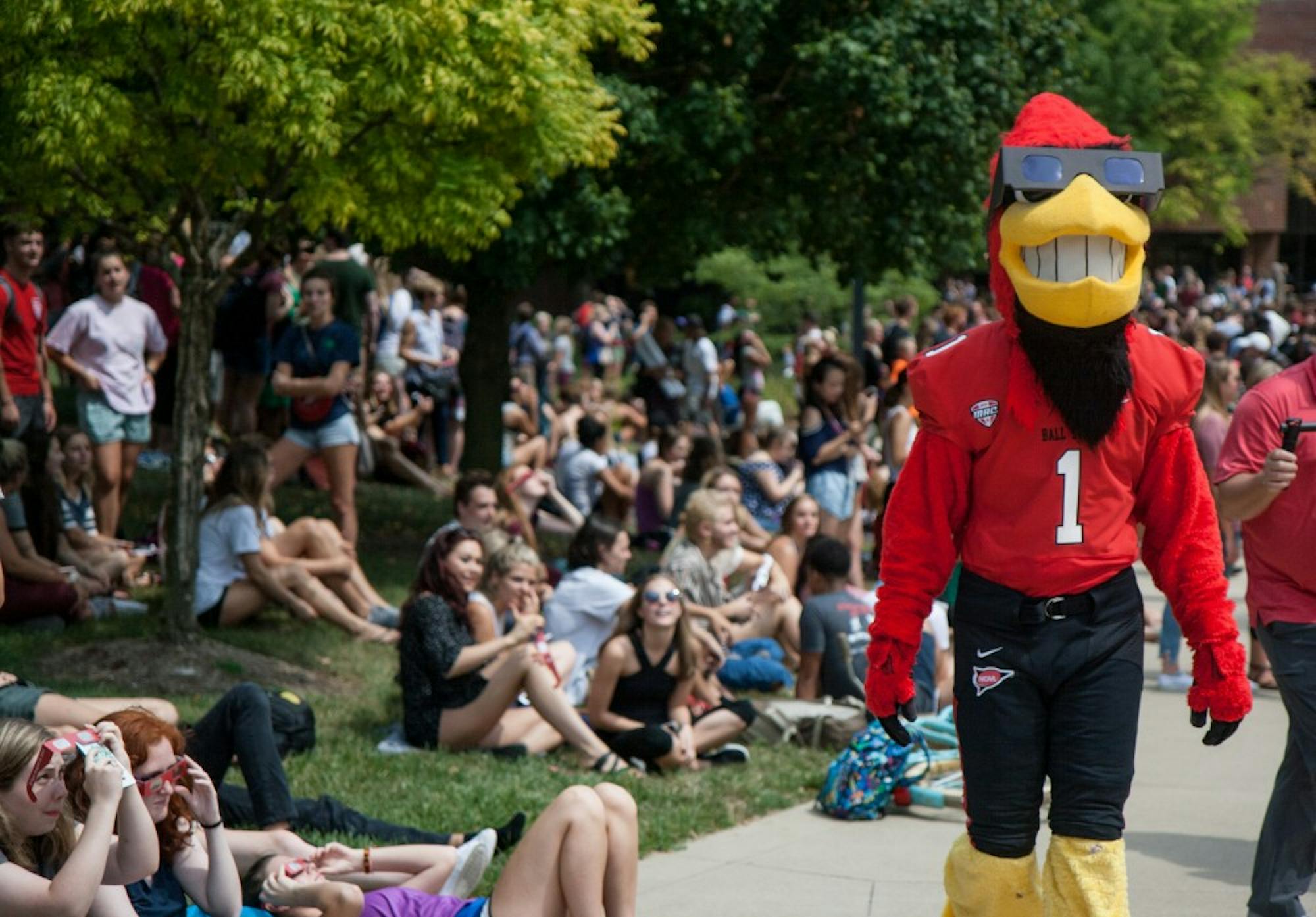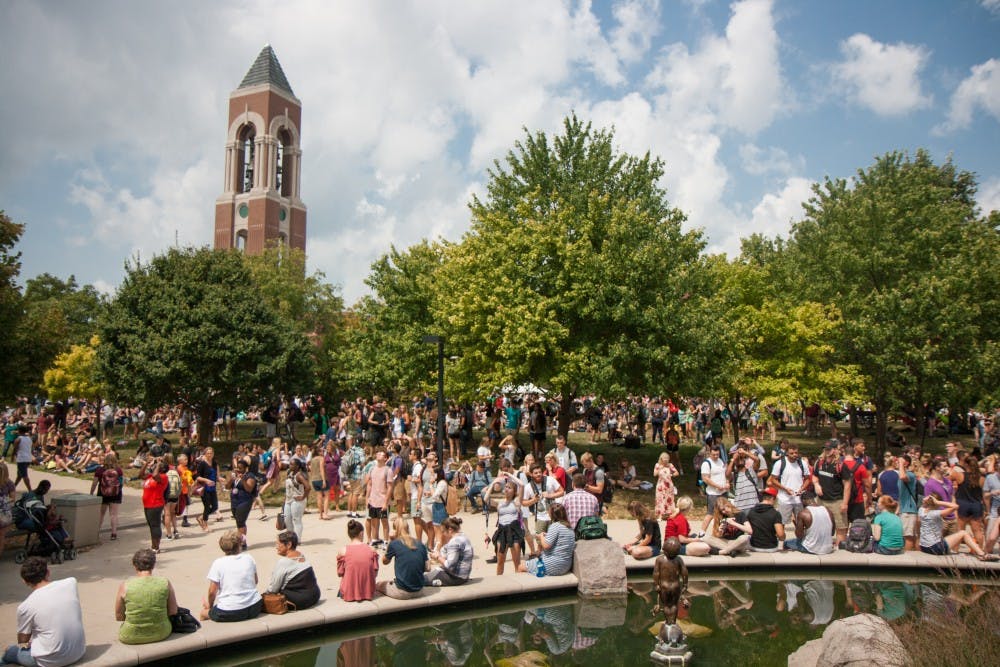It’s been almost 1,200 years since East-Central Indiana has seen a total solar eclipse. Delaware County locals and Ball State students are gearing up and learning about what’s to come.
John Millis, who serves as Ball State’s department chair of physics and astronomy, explained that totality in a solar eclipse happens when the moon completely blocks out the light from the sun’s disk (photosphere) from Earth’s point of view if you are in the path of totality.
Viewers are only able to see the outermost layer of the sun, the solar atmosphere — also called the Corona. It will appear to give a light glow on the edges of the moon, which is a part of the sun behind it.
“Because the sun is so bright, you normally can’t see the solar atmosphere, even though it does light up with radiation, it is so dim compared to the disk that we can’t normally see it,” Millis said. “During totality, when you have blocked all this light from the solar surface, the illumination from the solar atmosphere is now visible.”
The rare sight of totality runs through a few midwest and southern states including Texas, Arkansas, Kentucky, Indiana and Ohio. All of Muncie, Indiana, will be in the direct path of totality, something that has attracted many potential tourists. The time in totality is estimated to be three minutes and 40 seconds in Muncie.
“If you were to wait for a solar eclipse to come to you and not travel anywhere, you’d be waiting, on average, 375 years,” Nicolette Peyton Terracciano, a planetarium show specialist at the Brown Planetarium said. “But in the case of Muncie, we haven’t seen a total solar eclipse since the year 957.”
According to Ball State University, the eclipse will begin on campus at 1:52:13 p.m. ET, with totality starting at 3:07:37 p.m. ET. Totality will last until 3:11:15 p.m. ET. The eclipse ends at 4:24:16 p.m. ET. These times are estimated for Ball State’s campus only, meaning times may vary slightly by location.
Special protective eyewear is required to view the eclipse before and after absolute totality. It is essential to protect your eyes and follow safety guidelines explained by NASA.
“If you make a fist and squeeze it really hard for a long time, it will start to hurt, but you will know,” Terracciano said. “[But], you don’t have nerve endings in your eyes, so you don’t know the damage that is happening to your pupil until it is too late.”
Solar eclipse glasses are handed out at Charles W. Brown Planetarium leading up to the event, and bulk numbers can be requested via a request form. Students and faculty are encouraged to donate $1 per pair but are not required.
The eclipse can still be viewed without protective eyewear, as long as the viewer doesn’t look directly at the sun. According to Terracciano, during a total solar eclipse smaller shadows and reflections from the trees and bushes create crescent shapes. These shapes on the ground are safe to view without a pair of eclipse glasses.

Once the sky is dark and looks similar to nighttime, the eclipse will be in totality. During this time it is safe to take off glasses and view the eclipse directly. Once the Corona goes away and the sun is visible again, it is recommended to put the glasses back on or look away for safety.
Delaware County offers many events on the day of the eclipse and some people are planning to camp at Delaware County Indiana Fairgrounds to secure their spot to watch the eclipse with others.
“Citizens are turning this into a very special event for themselves and their families by just celebrating and having parties,” Terracciano said.
Fourth-year public relations major Madison Guimond said she has plans to travel to her parent’s house in Indianapolis to watch the eclipse.
Guimond said this is a “family tradition” as they watched the 2017 eclipse together in Illinois. Guimond said she feels that viewing an eclipse is grounding because of the deeper reflection of how small humans are in comparison to the planet, moon and stars.
“It is great to share the once-in-a-lifetime experience,” Guimond said. “We all really appreciate spending time together, especially because the experience is limited.”
While some students may be venturing outside of Muncie, others said they will view the eclipse from places around the city or on campus. Third-year computer science major Ashton Willis said he has not been able to watch an eclipse before and is excited for the upcoming one.
“I’ve always liked astronomy. It’s exciting that probably the first time I’ll see an eclipse, it will be a total one,” Willis said. “The moon is such a small object compared to other celestial bodies, so it has to be in that perfect angle in order to have totality in certain parts of the world.”
Altogether, April 8 will be a special day for the history books due to the rarity of all these moving parts aligning. It will likely leave a lasting impact on those who watch it as well.
“As long as you take time to view [an eclipse] and view them safely, it can be a life-changing experience,” Terracciano said.
Contact Ellie Marker with comments via email at eliana.marker@bsu.edu.





